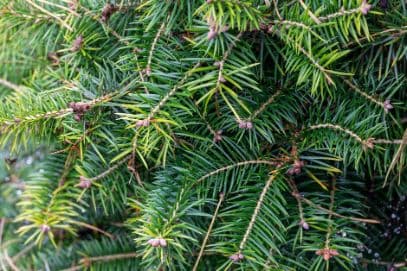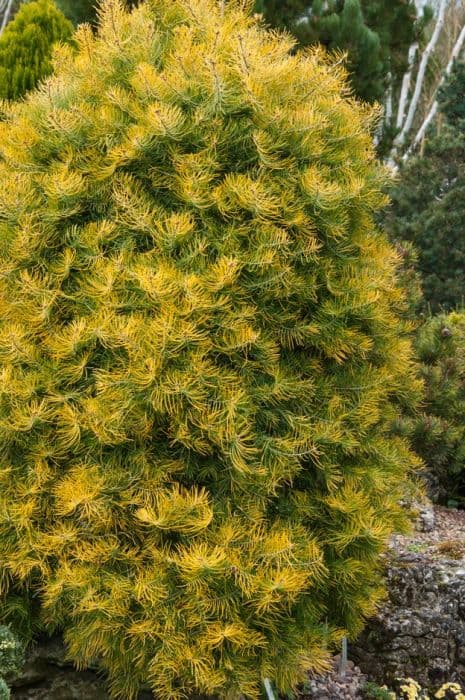Scots pine 'Gold Coin' Pinus sylvestris 'Gold Coin'

ABOUT
'Gold Coin' is a slow-growing evergreen shrub of irregular rounded habit, with bright light yellow foliage
About this plant
 Names
NamesFamily
Pinaceae.
Synonyms
Scots Pine, Scotch Pine, Baltic Pine, European Red Pine.
Common names
Pinus sylvestris 'Gold Coin'.
 Characteristics
CharacteristicsLife cycle
Perennials
Foliage type
Evergreen
Color of leaves
Green
Height
20-60 feet (6-18 meters)
Spread
20-40 feet (6-12 meters)
Plant type
Tree
Hardiness zones
2-7
Native area
Europe Asia
Benefits
 General Benefits
General Benefits- Ornamental Value: The Pinus sylvestris 'Gold Coin', commonly known as Scotch Pine, provides aesthetic value to landscapes with its unique golden foliage that intensifies in winter.
- Soil Stabilization: As with many pines, it has an extensive root system that helps to prevent soil erosion in the areas where it is planted.
- Habitat for Wildlife: It offers habitat and food for birds and other wildlife, with its branches providing shelter and its pine cones offering seeds for consumption.
- Drought Tolerance: Scotch Pine can tolerate periods of drought, making it suitable for xeriscaping and in regions where water conservation is important.
- Adaptability: It is adaptable to a variety of soil types, though it prefers well-drained soils, which makes it a versatile option for different landscapes.
- Windbreak: Its dense growth habit can serve as a windbreak, providing protection for gardens, buildings, and other plants against strong winds.
- Cold Hardy: This species of pine is particularly cold-resistant, making it suitable for colder climates where other plants may not thrive.
 Medical Properties
Medical PropertiesThis plant is not used for medical purposes.
 Air-purifying Qualities
Air-purifying QualitiesThis plant is not specifically known for air purifying qualities.
 Other Uses
Other Uses- Scots pine 'Gold Coin' needles can be used as a natural dye, producing a range of colors from green to yellow depending on the mordant used.
- The resin from Scots pine 'Gold Coin' can be collected and used as a sealant or adhesive in traditional crafts and small-scale repairs.
- Wood shavings and small branches of Scots pine 'Gold Coin' can be utilized as natural mulch, helping to retain soil moisture and suppress weeds.
- Dried Scots pine 'Gold Coin' needles can be incorporated into potpourri mixes for a woodsy aroma.
- Scots pine 'Gold Coin' cones can be used in decorative crafts, such as wreaths or as a natural ornament for holiday decor.
- The wood of Scots pine 'Gold Coin' is suitable for making rustic furniture or garden structures, such as trellises and arbors.
- Needles from Scots pine 'Gold Coin' can be used to stuff sachets, providing a fresh scent in drawers and closets.
- Scots pine 'Gold Coin' sawdust can be used in smoking foods to impart a distinct flavor, especially in Scandinavian cuisines.
- Scots pine 'Gold Coin' branches are traditionally used to make May Day baskets in some European cultures, symbolizing Spring and fertility.
- The tannins from the bark of Scots pine 'Gold Coin' could be used in tanning leather, although this is an older and less common practice now.
Interesting Facts
 Feng Shui
Feng ShuiThe Scots Pine is not used in Feng Shui practice.
 Zodiac Sign Compitability
Zodiac Sign CompitabilityThe Scots Pine is not used in astrology practice.
 Plant Symbolism
Plant Symbolism- Resilience - The Pinus sylvestris, commonly known as Scots Pine, often symbolizes resilience due to its hardiness and ability to grow in challenging environments.
- Longevity - Scots Pines are known for their long lifespan, and as such, they represent endurance and the continuity of life.
- Wisdom - In various cultures, pines have been associated with wisdom because they are some of the oldest trees, often standing tall through generations.
- Peace - Pines have been seen as a symbol of serenity and peace, offering calmness and tranquility.
- Fertility - The evergreen nature of the Scots Pine and its prolific seed cones represent fertility and new beginnings.
- Prosperity - The 'Gold Coin' variety, with its gold-hued foliage, suggests wealth and prosperity.
- Vitality - The robust nature of the Scots Pine, with its vigorous growth, signifies good health and vitality.
 Water
WaterThe Scots Pine, or Pinus sylvestris 'Gold Coin', prefers evenly moist soil, so water when the top inch of soil feels dry to the touch. This could roughly be around every 7 to 10 days during the active growth season, depending on weather conditions. Use approximately 1 to 2 gallons per watering for young trees, ensuring water reaches deep into the root zone. During dry spells, water the pine once a week. Reduce watering frequency in winter when the tree is dormant to prevent root rot, particularly if your region receives substantial rainfall.
 Light
LightScots Pine thrives in full sun conditions, meaning it requires at least six hours of direct, unfiltered sunlight each day. The ideal spot for this pine tree is in an open area unobstructed by buildings or taller trees to ensure it receives ample sunlight throughout the day. Avoid planting it in fully shaded areas as this can stunt growth and reduce the overall health of the tree.
 Temperature
TemperatureScots Pine can tolerate a wide range of temperatures, making it adaptable to many climates. It can survive temperatures as low as -40 degrees Fahrenheit and as high as 100 degrees Fahrenheit. The ideal temperature range is between 60 to 70 degrees Fahrenheit during the growing season. Ensure the tree is well-watered before a freeze to help it withstand the cold.
 Pruning
PruningPruning the Scots Pine is generally for aesthetic shaping, removing damaged branches, and promoting healthy growth. Prune during the dormant season in late winter or early spring before the new growth starts. Remove dead or broken branches and any weak growth to maintain the tree's shape and health. Avoid excessive pruning as pines do not require it as frequently as other trees.
 Cleaning
CleaningNot needed
 Soil
SoilScotch Pine 'Gold Coin' prefers well-drained soil with a pH range between 5.5 and 6.5. A good soil mix would be one part peat, one part pine bark, and one part coarse sand to ensure proper drainage and aeration, crucial for the health of the root system.
 Repotting
RepottingThe Scotch Pine 'Gold Coin' typically needs repotting every 2 to 4 years to refresh the soil and prevent root binding. It's best to repot in the late winter or early spring before new growth begins.
 Humidity & Misting
Humidity & MistingScotch Pine 'Gold Coin' is adaptable to a wide range of humidity levels and does well in average outdoor humidity. This species does not have specific humidity requirements and is quite hardy against varying atmospheric moisture levels.
 Suitable locations
Suitable locationsIndoor
Place Scotch Pine 'Gold Coin' in bright light; water sparingly.
Outdoor
Provide full sun, well-drained soil for Scotch Pine 'Gold Coin'.
Hardiness zone
3-7 USDA
 Life cycle
Life cycleScots Pine 'Gold Coin' begins its life as a seed, typically germinating in spring under favorable moisture and temperature conditions. After germination, the seedling stage involves the growth of a taproot and the emergence of cotyledons, followed by true leaves, as it establishes itself. During the sapling stage, the plant experiences rapid vertical growth, developing a strong trunk and branching structure with the characteristic yellowish foliage. As it matures into an adult tree, the Scots Pine 'Gold Coin' develops reproductive structures; male cones release pollen while female cones wait to be fertilized. Once pollinated, the female cones mature over time, typically taking a couple of years before releasing seeds to start a new generation. Throughout its life, which can span several decades, this evergreen conifer undergoes seasonal needle shedding and replaces old growth with new.
 Propogation
PropogationPropogation time
Early spring
The most popular method of propagating Scots Pine 'Gold Coin' is through seed collection and sowing. The best time to collect seeds is in late summer or early autumn when the cones have matured and begun to open. Gather the cones and allow them to dry in a warm place so they release the seeds. Seeds can be sown in well-draining soil, ideally in a cold frame or under controlled conditions that mimic winter, as chilling is required for germination. The soil temperature should be maintained at about 60-70 degrees Fahrenheit (15-21 degrees Celsius) for germination, and after sprouts appear, it’s crucial to ensure that seedlings have adequate light and moisture to grow strong enough for eventual transplanting.









